Last week, I described a birding trip to the top of Mt. Wrightson as part of my friend Pam Keyes’ video series for female hikers over 50. Be sure to enjoy her ten-minute video that accompanies this two-part series. I never expected to receive such valuable lessons in humility on the descent.
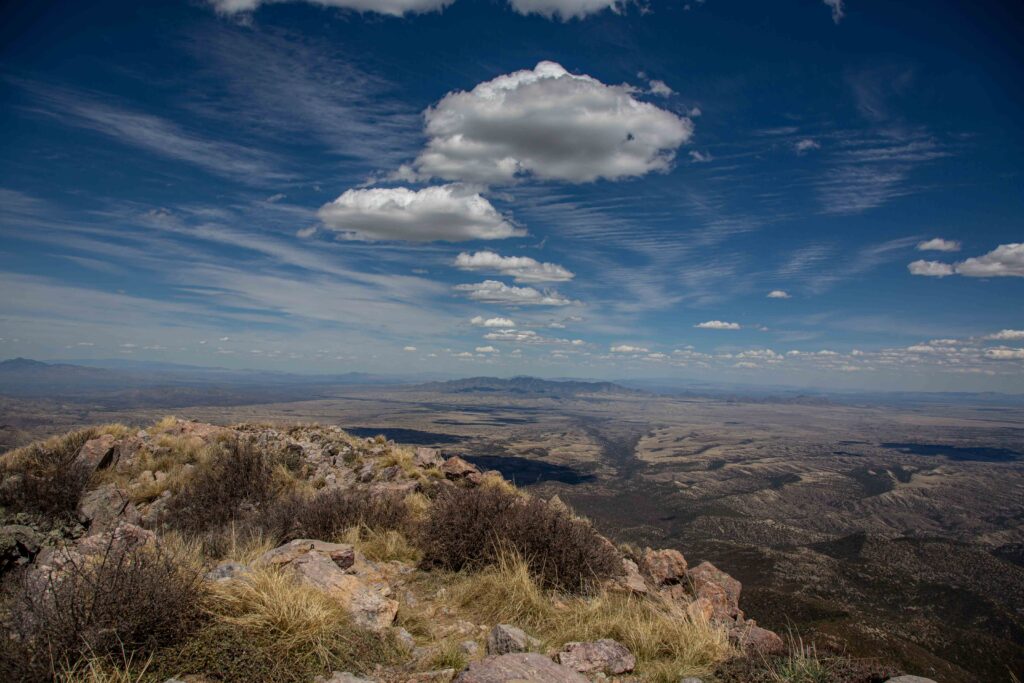
The Approach
Before we reached our lunch spot, Pam received a text from her son Zach, a Type-1 Diabetic, that his blood sugar levels needed checking. Cell service is intermittent in the Santa Rita Mountains, depending on one’s provider. I had no service until we left the mountain, but Pam’s worked fine. We’d had a similar experience in Alaska so I wasn’t all that surprised. I almost never use my phone when I ramble with Ajax in the mountains except to take pictures.
Since Pam was able to track her son’s progress, we knew he’d reach the summit before we did. At one point we received a text asking if we had turned around. With so many switchbacks, it was understandable why someone might interpret your dot as going down rather than up. She assured him we were on our way, but if he wanted to head down before we got to the summit, he could.
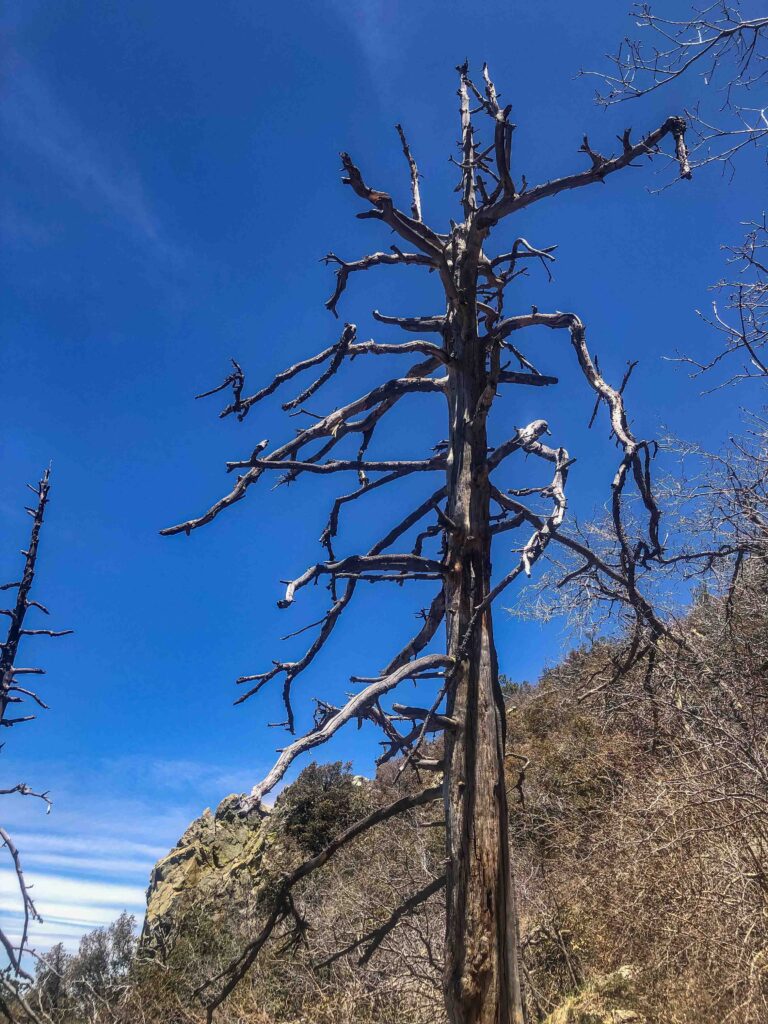
As we climbed steep switchbacks toward Old Baldy Saddle, the birdsong disappeared. A few turkey vultures and dozens of ravens soared on thermals. The views became more dramatic, as did the sun’s intensity. Having had a number of basal cell carcinomas removed over the years, I keep my skin covered even on hot days. I relished the few breezes that passed through on the sun-scorched slope.
Old Baldy Saddle
At Old Baldy Saddle, the wind increased. I knew we had less than a mile to go, but plenty of elevation to gain. The sight of a couple of hikers in front of us awakened my competitive spirit. Maybe I could pass them.
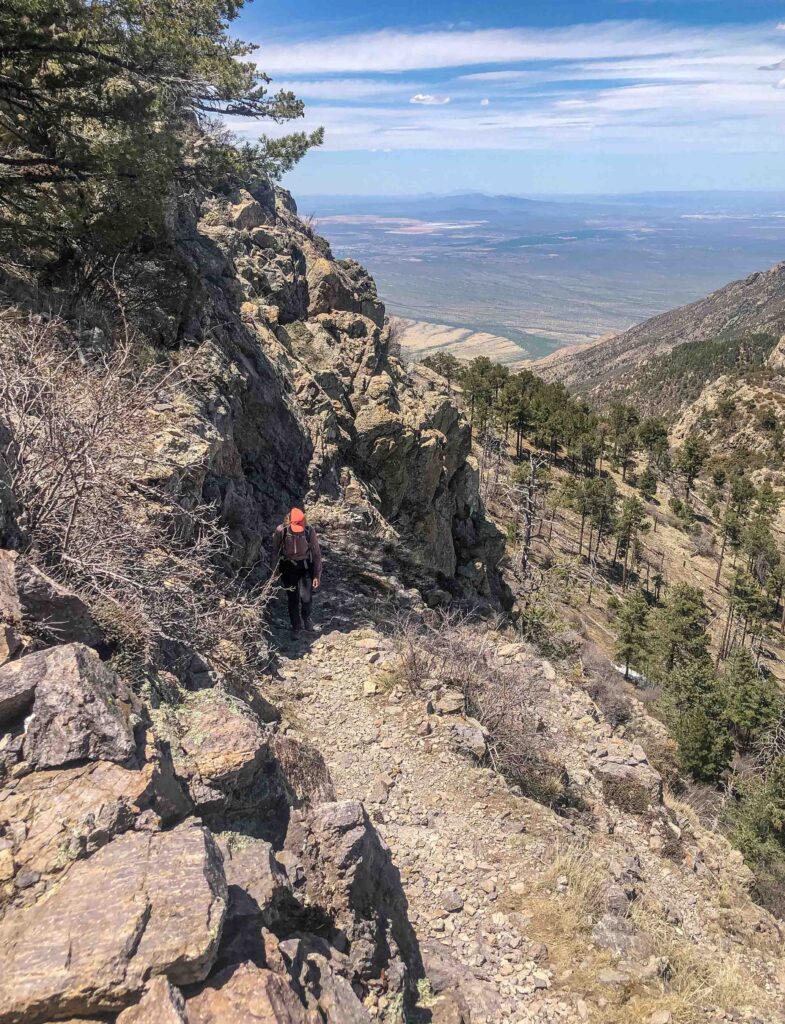
Pam insisted I go ahead and she’d follow. I picked up my pace, snapping photos along the way. I marveled at the terrain we’d traversed, including the winding path back to Old Baldy Saddle. A few minutes from the top, a ground squirrel stared at me, as if begging for handouts. Until that point, we had heard plenty of birds and seen a few lizards, but no mammals.

Summit Experience
Around 1:30, I reached the summit. A rock ring remains the only indicator of the fire lookout tower that burned down in 1973. After greeting Zach and telling him his mom would be up shortly, I found a good spot so I could record her arrival.
Zach continued chatting with the other hikers. He looked refreshed, not at all like he’d gained 4,000 feet of elevation over 6 miles.
“We took good care of him,” several of the hikers promised, assuring us that they’d shared their sunscreen, food, and water. “He’s a good kid,” another man, Dave, added.

When Zach asked if I had any extra food, I handed him an apple. I also had an entire bag of trail mix, but the last thing I wanted to do was eat.
Lessons in Humility: Dwindling Water
Of greater concern was my dwindling water supply. In the Cascades, 3.5 liters is enough for a 15-mile hike. With my dog. With leftovers. But in SE Arizona, it only carried me halfway. As I downed my last few swallows of Keppi lemon-lime electrolytes water I remembered I still carried Pam’s completely full two-liter bag. Perhaps she could spare some.
When Dave, one of the men trading stories with Zach, offered me some water “to lighten his load,” I gratefully accepted. The ice-cold temperature made up for the bland flavor.
With a liter from Pam and another half liter generously supplied by Dave, I felt confident I’d have enough for the trip down. I also predicted that my mild headache (presumably from altitude) would abate as we descended. We probably could reach the car in two hours. Down is always faster.
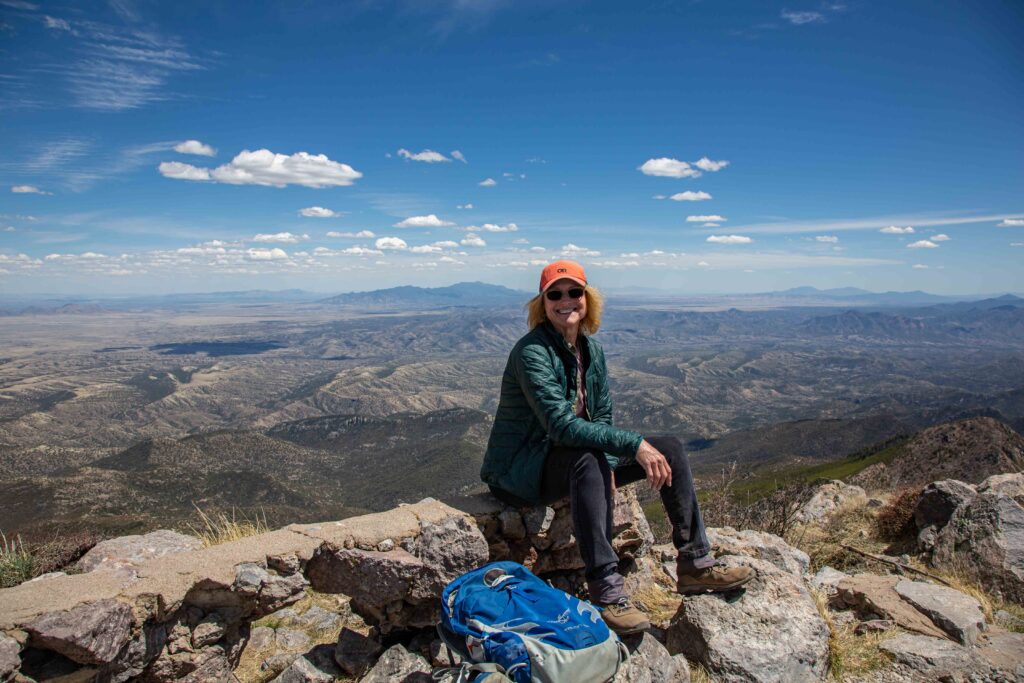
I took several last shots with my DSLR camera. I’d carried the extra weight up, and by golly, I was going to use it! My last task was to sign the summit register. Camera and binoculars stowed, and after enjoying the summit for half an hour, we started down.
Rejoining Walt
When we reached Old Baldy Saddle we got a pleasant surprise: Walt! He had continued up from his earlier resting spot. What wasn’t a surprise was that Zach had taken the car keys and continued down alone. He struck me as a remarkably independent and capable teenager.
At the summit, I’d considered asking Pam if I could use her phone at the Saddle to let my husband know we were running long. I forgot. As we started down the sun-baked switchbacks, Pam handed me her phone. Everything changed.
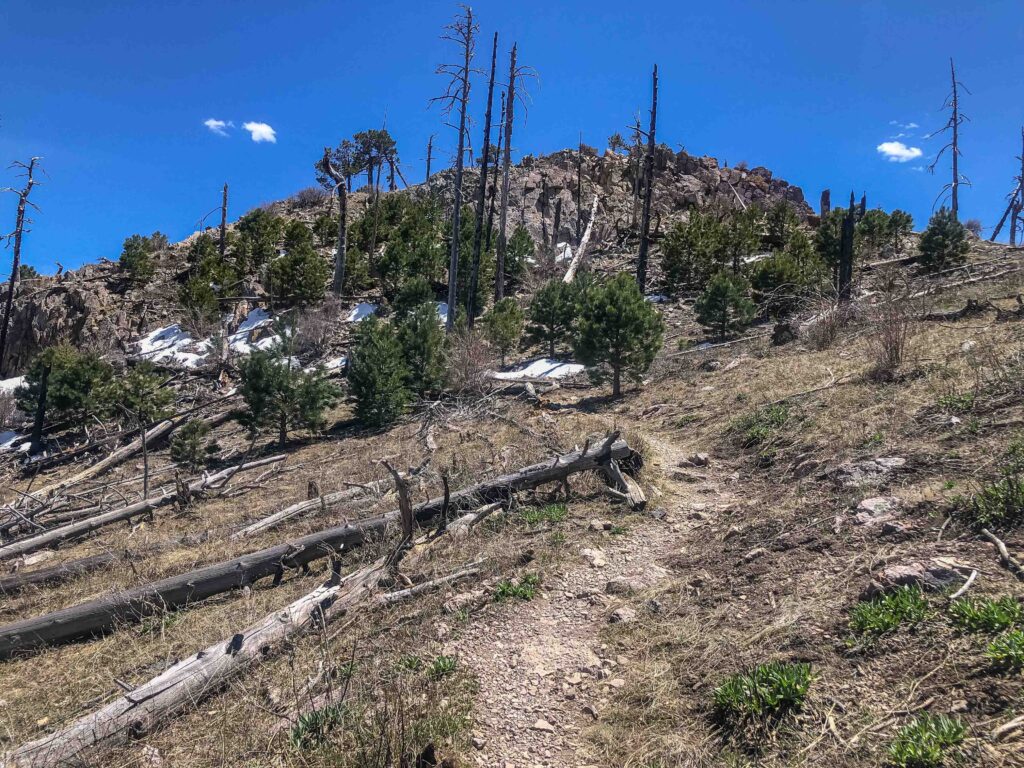
Lessons in Humility: Warning Signs
My headache got progressively worse, not better. I finally asked Pam if she had any painkillers. Ibuprofen is a staple in most First Aid kits, but it’s contra-indicated for me. I couldn’t come up with the word “Tylenol” to save my life. She also noticed that my face was quite red despite wearing a hat and sunscreen. Despite doing everything right, including staying hydrated, protecting sensitive skin from the sun, eating, and replacing valuable electolytes, my body needed help cooling down.

Bellows Spring Revisited
When we reached Bellows Spring, I grabbed the magenta scarf from my pack and soaked it in the trickle of water from the snow. That first squeeze of cool water on my face felt like I’d died and gone to heaven.
At some point, Walt reappeared (Had he waited for us? Had she texted him? Was he still recording video for her project?) Pam explained her concerns about my overheating. “We’ll just take it slow on the way down. Lots of breaks,” they said. Wait, what? I’m usually fastest on the descent. What the heck was going on?

“Put your whole hat in the stream and get it wet, too,” they suggested. Oh my goodness, pure bliss. For several minutes after that, I felt invincible. Until nausea and headache continued.
“Take your scarf off every so often so your body can get rid of the heat,” they suggested. Pam shared stories of two people she’d helped in the past who had heat stroke. One ended up in the hospital. I won’t. No more hospitals for ME!

Heat Illnesses
Hearing her use the word “stroke” jarred me. I knew from all my first aid training that heat cramps, heat exhaustion, and heat stroke (also known as sunstroke) are very real concerns for people unaccustomed to training in hot, arid conditions.
I am a snow girl through and through. I’ve experienced cramps before, but I couldn’t see my hot face or detect my slurred speech. I just knew I felt very warm, nauseous, headachey, and HOT. But this could definitely be heat exhaustion. If I wasn’t careful, it could deepen into something much more serious.
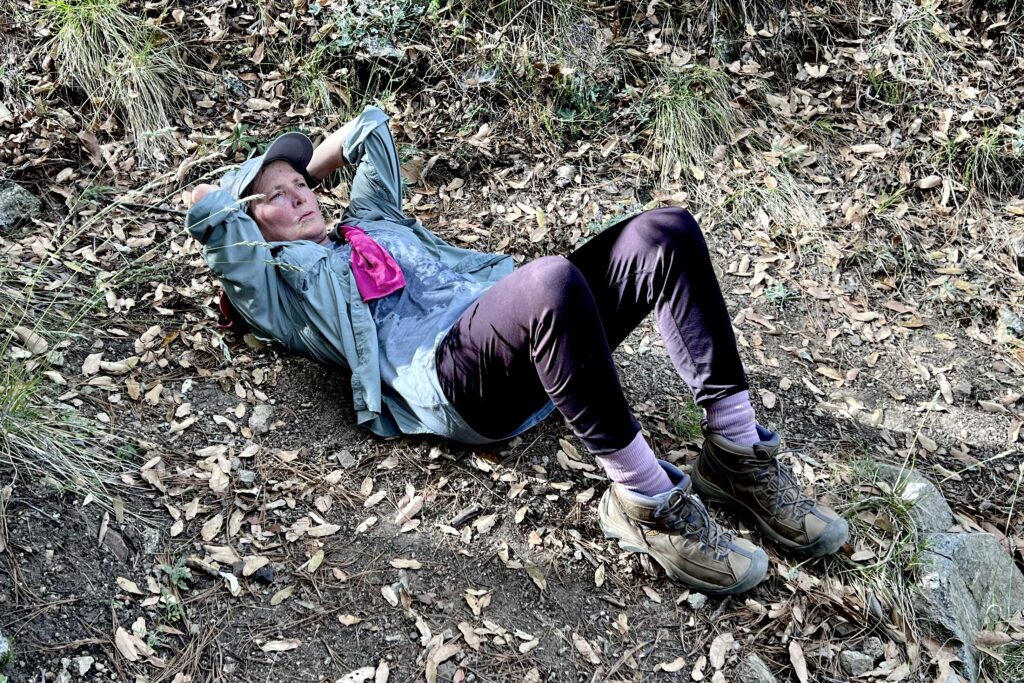
When we finally reached shade, Pam suggested I remove my long-sleeved shirt and hat. She offered to take my pack. I hesitated for a split second before accepting her help. The next thing I knew, she was pouring water all over my shirt. “This will help your body cool down.”
Lessons In Humility: Accept Help
Pam asked if it would be okay to include my experience with heat exhaustion in the video. I hesitated again. What does it say about me that I had trouble on the last two miles of an 11-mile hike? Would people think less of me?
But a second later, I agreed. I looked down at my Go for Good wristband and reminded myself of my intentions to see the positives in every negative outcome. How could I turn what I perceived, in the moment, as a failure into a valuable learning experience, for myself, and for my readers? What lessons came from it?
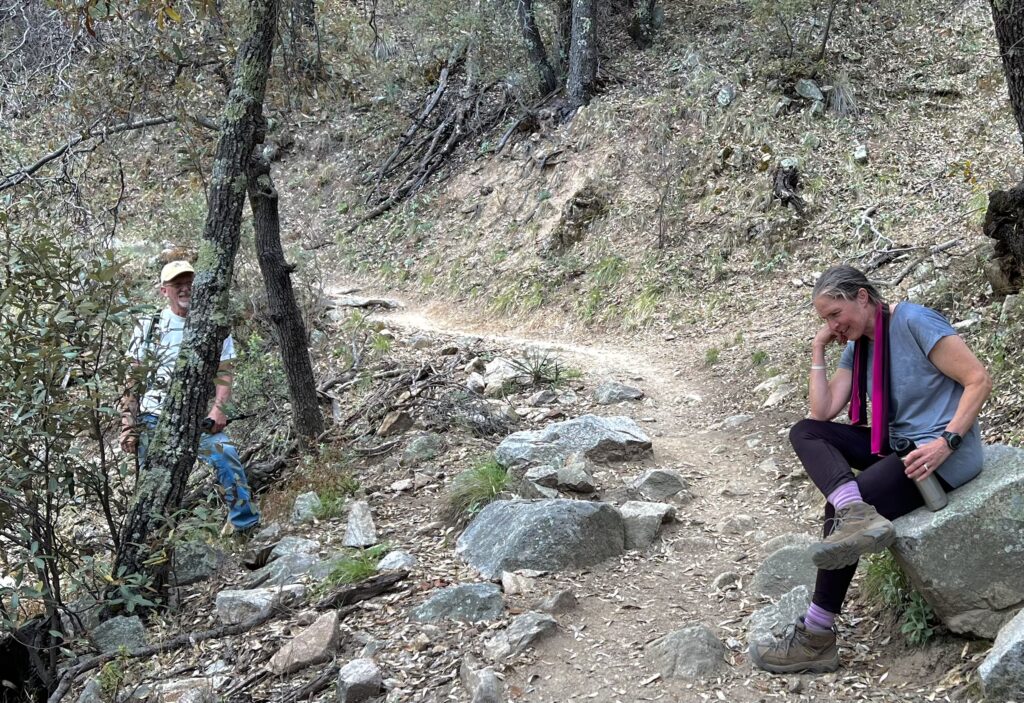
- No matter how fit or well-prepared you are, something unexpected can still happen.
- Do what you can to prevent heat illness and heed warning signs of a potential problem.
- Realize that one event does not mean it will happen again, whether you experience heat or cold illness, or altitude sickness. Every trip is unique.
- The scouts’ motto, “Be prepared,” applies on every trip. Expect the unexpected and you won’t be surprised.
- Always carry MORE than you think you will need, especially if you don’t expect to find a water source.
- Realize that when you’re at the summit you’re only halfway done. Most problems occur on the way down.
- Accept help readily and graciously when someone offers. I owe Pam my life and I’d do it all again.
Perhaps the most surprising part of the whole trip was the great time we had collaborating on Pam’s wonderful video project. Experience Wrightson for yourself in Pam’s ten-minute video, including the 28 bird species we encountered during our adventure.


Thanks for sharing this post. I couldn’t hike in these “hot” conditions. You were lucky to have people around you to assist you. If you would have been soloing, maybe you would have turned at your first warning sign (mild headache) after you have done everything right. I love you keep your “cool” & sense of humour. This can happen to anyone, even with the best preparation.
The video is amazing. Very well presented and interesting. I love it.
Keep doing what you do. Looking forward to your next blog.
Thanks for the comment, Silvie Marie. Yes, I was very lucky to have someone around who knew the signs. Left on my own I would have pressed on and possibly had more trouble.
I’ve thought about that hike often, obviously, with two Blog posts and a video about it. I am a cool weather hiker, for sure. But what’s more, when I hike with my dog I use him as my barometer. I choose shaded hikes with running water, and don’t even GO if it’s over 75 because I know he’ll be uncomfortable. So I truly am NOT accustomed to hotter weather. The few I’ve done when it’s hot, such as Kendall Katwalk or Granite, I’ve taken breaks when he overheats and I’ve been able to go in shortsleeves because of the shade and the very early hour. I may have done everything right but there is still more I could have done differently. Live and learn.
Glad you enjoyed the video. Pam and Walt are remarkably talented with their videography. I have much to learn from them! My next Blog will follow soon, on Mt. Washington and lessons applied from the Wrightson experience. The fun continues!